Research Proposal: Disposal Options for Derelict Ships and Boats
VerifiedAdded on 2022/10/04
|14
|2985
|20
Project
AI Summary
This research proposal investigates the identification of optimal disposal options for derelict ships and boats, addressing the critical issue of marine pollution caused by ship-generated waste. The proposal outlines the background, emphasizing the increasing waste generation from ships, including oil, chemicals, and plastics, and the resulting impact on marine ecosystems and legislative frameworks. It highlights research gaps, particularly the need for effective disposal techniques and the impact of waste on marine life. The research aims to identify effective disposal techniques, introduce measurable waste analysis techniques, and assess the environmental impact of current disposal practices in the South Australian gulf. The methodology includes secondary data collection from journals and articles, primary data collection using random sampling of ship employees, on-site disposal surveys, and desktop-based approaches using GIS and pH value measurements. Data analysis will be conducted using quantitative and qualitative techniques, adhering to ethical guidelines, and ensuring the privacy of participants. The proposal also includes a research budget and a comprehensive list of references.
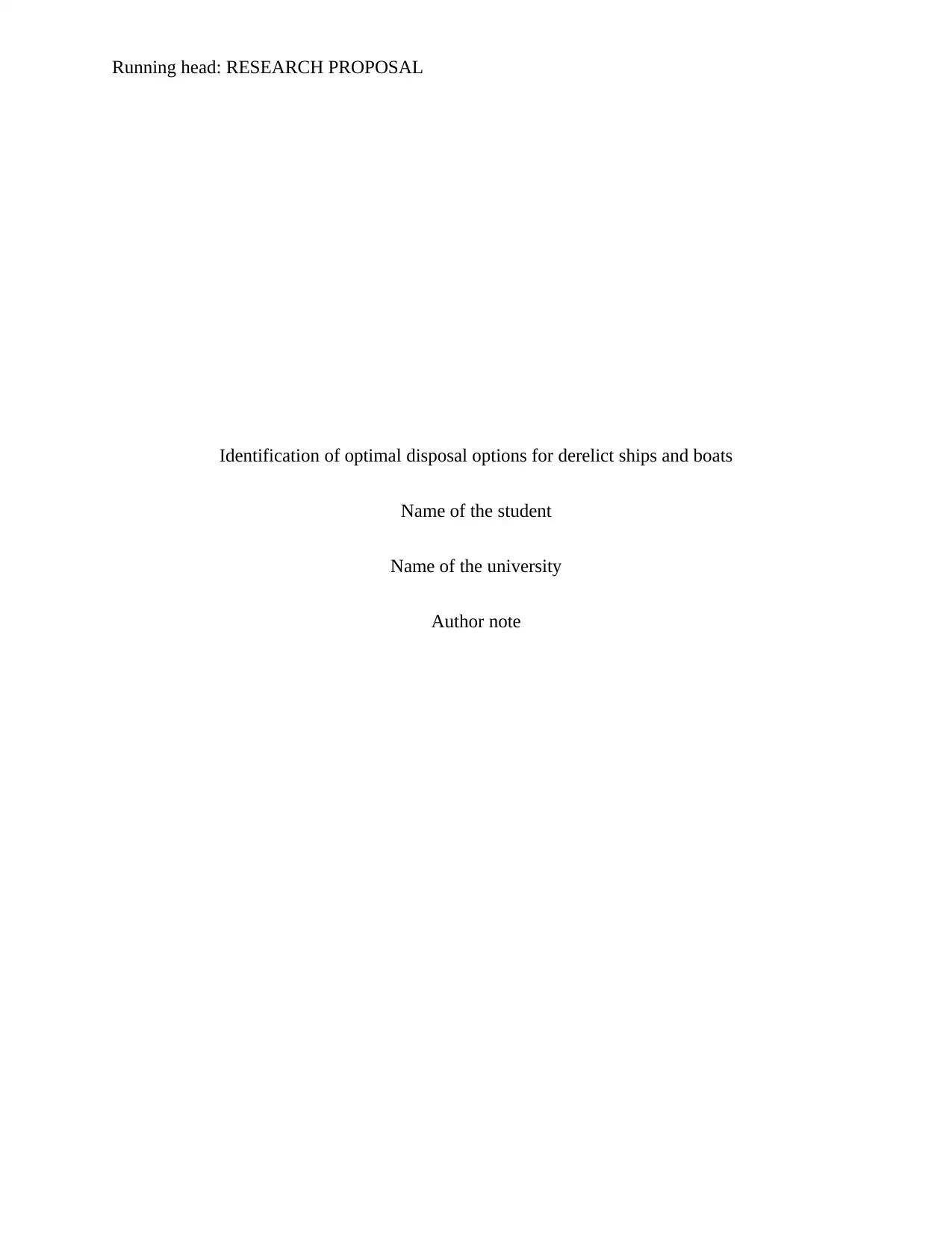
Running head: RESEARCH PROPOSAL
Identification of optimal disposal options for derelict ships and boats
Name of the student
Name of the university
Author note
Identification of optimal disposal options for derelict ships and boats
Name of the student
Name of the university
Author note
Paraphrase This Document
Need a fresh take? Get an instant paraphrase of this document with our AI Paraphraser
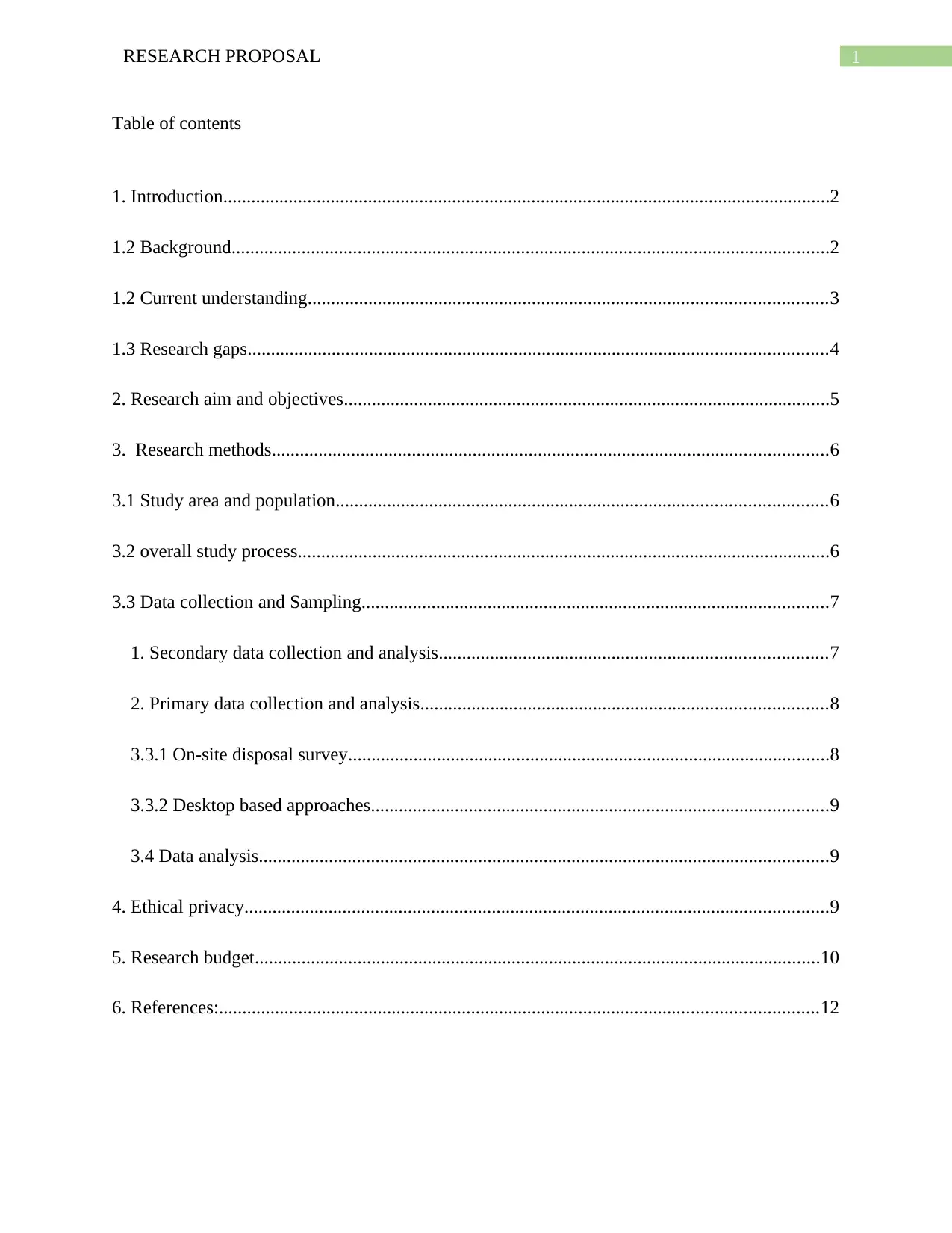
1RESEARCH PROPOSAL
Table of contents
1. Introduction..................................................................................................................................2
1.2 Background................................................................................................................................2
1.2 Current understanding...............................................................................................................3
1.3 Research gaps............................................................................................................................4
2. Research aim and objectives........................................................................................................5
3. Research methods.......................................................................................................................6
3.1 Study area and population.........................................................................................................6
3.2 overall study process..................................................................................................................6
3.3 Data collection and Sampling....................................................................................................7
1. Secondary data collection and analysis...................................................................................7
2. Primary data collection and analysis.......................................................................................8
3.3.1 On-site disposal survey.......................................................................................................8
3.3.2 Desktop based approaches..................................................................................................9
3.4 Data analysis..........................................................................................................................9
4. Ethical privacy.............................................................................................................................9
5. Research budget.........................................................................................................................10
6. References:................................................................................................................................12
Table of contents
1. Introduction..................................................................................................................................2
1.2 Background................................................................................................................................2
1.2 Current understanding...............................................................................................................3
1.3 Research gaps............................................................................................................................4
2. Research aim and objectives........................................................................................................5
3. Research methods.......................................................................................................................6
3.1 Study area and population.........................................................................................................6
3.2 overall study process..................................................................................................................6
3.3 Data collection and Sampling....................................................................................................7
1. Secondary data collection and analysis...................................................................................7
2. Primary data collection and analysis.......................................................................................8
3.3.1 On-site disposal survey.......................................................................................................8
3.3.2 Desktop based approaches..................................................................................................9
3.4 Data analysis..........................................................................................................................9
4. Ethical privacy.............................................................................................................................9
5. Research budget.........................................................................................................................10
6. References:................................................................................................................................12
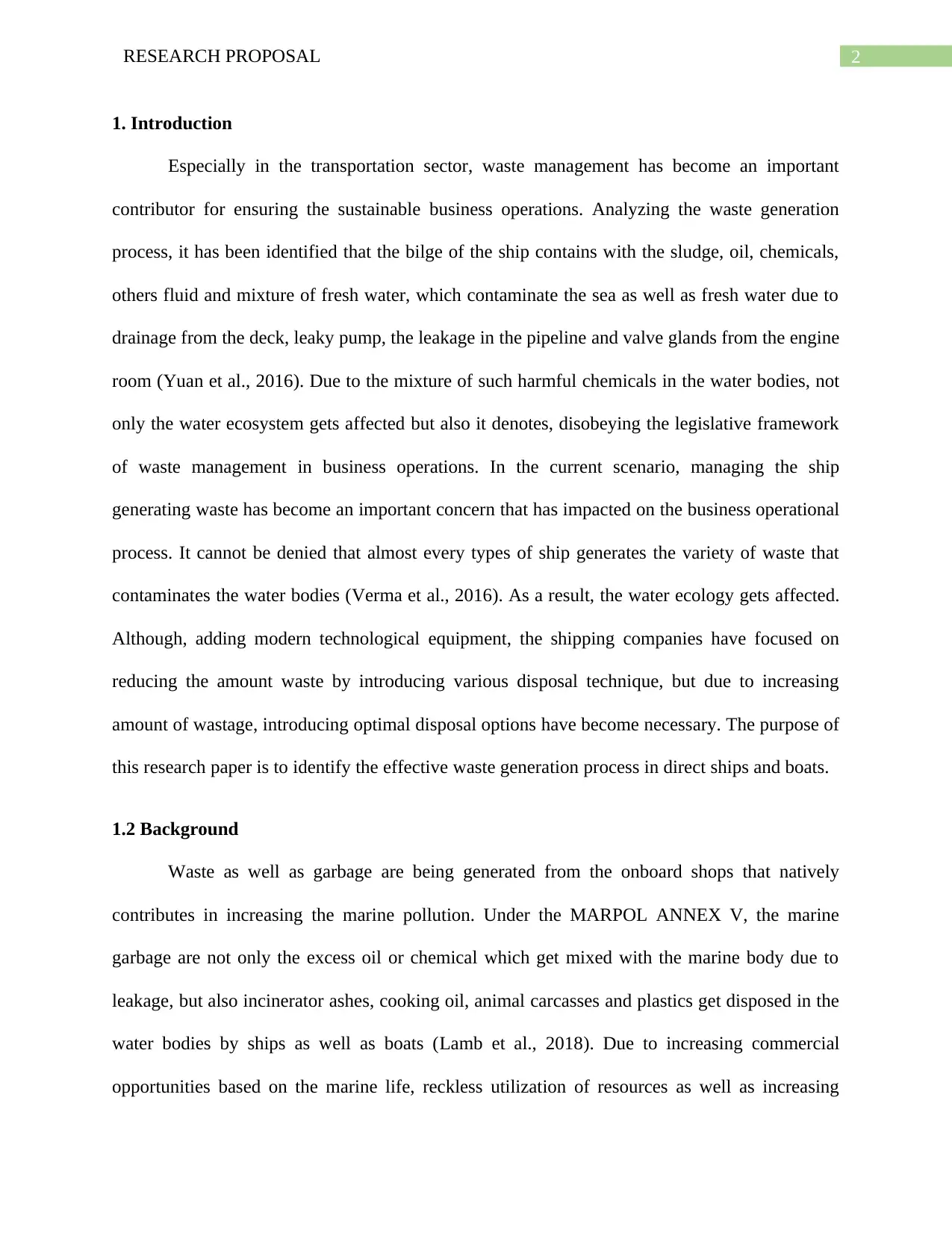
2RESEARCH PROPOSAL
1. Introduction
Especially in the transportation sector, waste management has become an important
contributor for ensuring the sustainable business operations. Analyzing the waste generation
process, it has been identified that the bilge of the ship contains with the sludge, oil, chemicals,
others fluid and mixture of fresh water, which contaminate the sea as well as fresh water due to
drainage from the deck, leaky pump, the leakage in the pipeline and valve glands from the engine
room (Yuan et al., 2016). Due to the mixture of such harmful chemicals in the water bodies, not
only the water ecosystem gets affected but also it denotes, disobeying the legislative framework
of waste management in business operations. In the current scenario, managing the ship
generating waste has become an important concern that has impacted on the business operational
process. It cannot be denied that almost every types of ship generates the variety of waste that
contaminates the water bodies (Verma et al., 2016). As a result, the water ecology gets affected.
Although, adding modern technological equipment, the shipping companies have focused on
reducing the amount waste by introducing various disposal technique, but due to increasing
amount of wastage, introducing optimal disposal options have become necessary. The purpose of
this research paper is to identify the effective waste generation process in direct ships and boats.
1.2 Background
Waste as well as garbage are being generated from the onboard shops that natively
contributes in increasing the marine pollution. Under the MARPOL ANNEX V, the marine
garbage are not only the excess oil or chemical which get mixed with the marine body due to
leakage, but also incinerator ashes, cooking oil, animal carcasses and plastics get disposed in the
water bodies by ships as well as boats (Lamb et al., 2018). Due to increasing commercial
opportunities based on the marine life, reckless utilization of resources as well as increasing
1. Introduction
Especially in the transportation sector, waste management has become an important
contributor for ensuring the sustainable business operations. Analyzing the waste generation
process, it has been identified that the bilge of the ship contains with the sludge, oil, chemicals,
others fluid and mixture of fresh water, which contaminate the sea as well as fresh water due to
drainage from the deck, leaky pump, the leakage in the pipeline and valve glands from the engine
room (Yuan et al., 2016). Due to the mixture of such harmful chemicals in the water bodies, not
only the water ecosystem gets affected but also it denotes, disobeying the legislative framework
of waste management in business operations. In the current scenario, managing the ship
generating waste has become an important concern that has impacted on the business operational
process. It cannot be denied that almost every types of ship generates the variety of waste that
contaminates the water bodies (Verma et al., 2016). As a result, the water ecology gets affected.
Although, adding modern technological equipment, the shipping companies have focused on
reducing the amount waste by introducing various disposal technique, but due to increasing
amount of wastage, introducing optimal disposal options have become necessary. The purpose of
this research paper is to identify the effective waste generation process in direct ships and boats.
1.2 Background
Waste as well as garbage are being generated from the onboard shops that natively
contributes in increasing the marine pollution. Under the MARPOL ANNEX V, the marine
garbage are not only the excess oil or chemical which get mixed with the marine body due to
leakage, but also incinerator ashes, cooking oil, animal carcasses and plastics get disposed in the
water bodies by ships as well as boats (Lamb et al., 2018). Due to increasing commercial
opportunities based on the marine life, reckless utilization of resources as well as increasing
⊘ This is a preview!⊘
Do you want full access?
Subscribe today to unlock all pages.

Trusted by 1+ million students worldwide
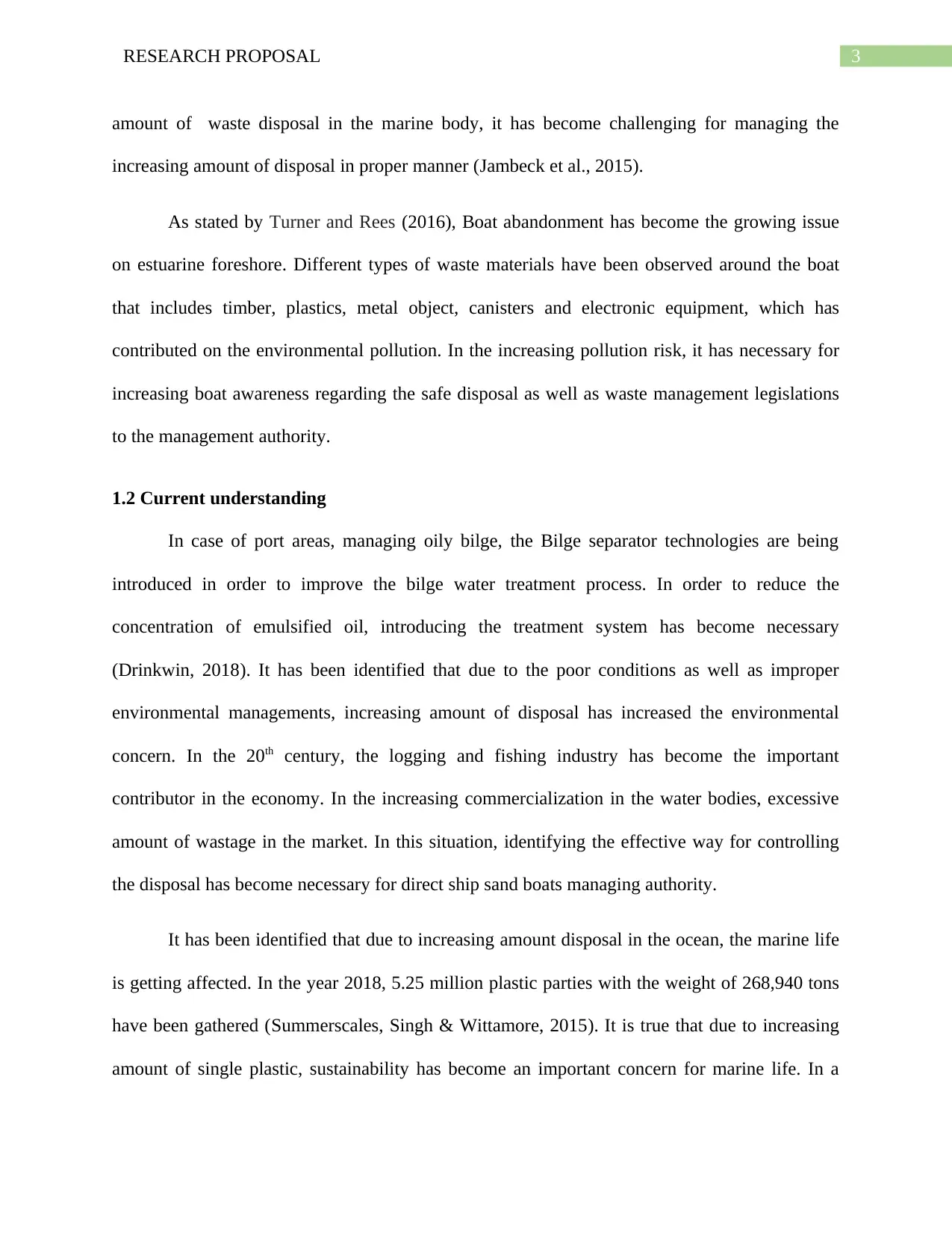
3RESEARCH PROPOSAL
amount of waste disposal in the marine body, it has become challenging for managing the
increasing amount of disposal in proper manner (Jambeck et al., 2015).
As stated by Turner and Rees (2016), Boat abandonment has become the growing issue
on estuarine foreshore. Different types of waste materials have been observed around the boat
that includes timber, plastics, metal object, canisters and electronic equipment, which has
contributed on the environmental pollution. In the increasing pollution risk, it has necessary for
increasing boat awareness regarding the safe disposal as well as waste management legislations
to the management authority.
1.2 Current understanding
In case of port areas, managing oily bilge, the Bilge separator technologies are being
introduced in order to improve the bilge water treatment process. In order to reduce the
concentration of emulsified oil, introducing the treatment system has become necessary
(Drinkwin, 2018). It has been identified that due to the poor conditions as well as improper
environmental managements, increasing amount of disposal has increased the environmental
concern. In the 20th century, the logging and fishing industry has become the important
contributor in the economy. In the increasing commercialization in the water bodies, excessive
amount of wastage in the market. In this situation, identifying the effective way for controlling
the disposal has become necessary for direct ship sand boats managing authority.
It has been identified that due to increasing amount disposal in the ocean, the marine life
is getting affected. In the year 2018, 5.25 million plastic parties with the weight of 268,940 tons
have been gathered (Summerscales, Singh & Wittamore, 2015). It is true that due to increasing
amount of single plastic, sustainability has become an important concern for marine life. In a
amount of waste disposal in the marine body, it has become challenging for managing the
increasing amount of disposal in proper manner (Jambeck et al., 2015).
As stated by Turner and Rees (2016), Boat abandonment has become the growing issue
on estuarine foreshore. Different types of waste materials have been observed around the boat
that includes timber, plastics, metal object, canisters and electronic equipment, which has
contributed on the environmental pollution. In the increasing pollution risk, it has necessary for
increasing boat awareness regarding the safe disposal as well as waste management legislations
to the management authority.
1.2 Current understanding
In case of port areas, managing oily bilge, the Bilge separator technologies are being
introduced in order to improve the bilge water treatment process. In order to reduce the
concentration of emulsified oil, introducing the treatment system has become necessary
(Drinkwin, 2018). It has been identified that due to the poor conditions as well as improper
environmental managements, increasing amount of disposal has increased the environmental
concern. In the 20th century, the logging and fishing industry has become the important
contributor in the economy. In the increasing commercialization in the water bodies, excessive
amount of wastage in the market. In this situation, identifying the effective way for controlling
the disposal has become necessary for direct ship sand boats managing authority.
It has been identified that due to increasing amount disposal in the ocean, the marine life
is getting affected. In the year 2018, 5.25 million plastic parties with the weight of 268,940 tons
have been gathered (Summerscales, Singh & Wittamore, 2015). It is true that due to increasing
amount of single plastic, sustainability has become an important concern for marine life. In a
Paraphrase This Document
Need a fresh take? Get an instant paraphrase of this document with our AI Paraphraser
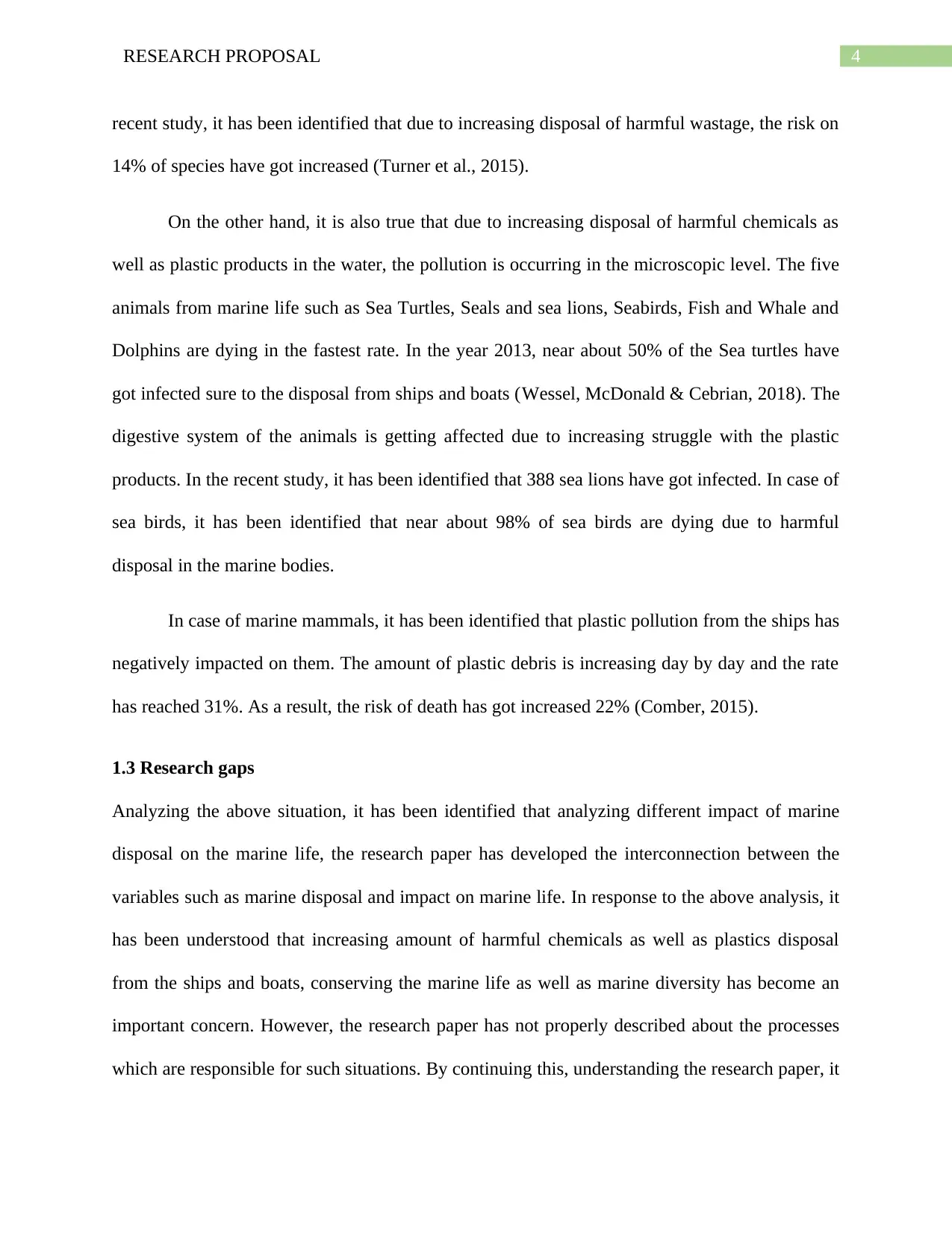
4RESEARCH PROPOSAL
recent study, it has been identified that due to increasing disposal of harmful wastage, the risk on
14% of species have got increased (Turner et al., 2015).
On the other hand, it is also true that due to increasing disposal of harmful chemicals as
well as plastic products in the water, the pollution is occurring in the microscopic level. The five
animals from marine life such as Sea Turtles, Seals and sea lions, Seabirds, Fish and Whale and
Dolphins are dying in the fastest rate. In the year 2013, near about 50% of the Sea turtles have
got infected sure to the disposal from ships and boats (Wessel, McDonald & Cebrian, 2018). The
digestive system of the animals is getting affected due to increasing struggle with the plastic
products. In the recent study, it has been identified that 388 sea lions have got infected. In case of
sea birds, it has been identified that near about 98% of sea birds are dying due to harmful
disposal in the marine bodies.
In case of marine mammals, it has been identified that plastic pollution from the ships has
negatively impacted on them. The amount of plastic debris is increasing day by day and the rate
has reached 31%. As a result, the risk of death has got increased 22% (Comber, 2015).
1.3 Research gaps
Analyzing the above situation, it has been identified that analyzing different impact of marine
disposal on the marine life, the research paper has developed the interconnection between the
variables such as marine disposal and impact on marine life. In response to the above analysis, it
has been understood that increasing amount of harmful chemicals as well as plastics disposal
from the ships and boats, conserving the marine life as well as marine diversity has become an
important concern. However, the research paper has not properly described about the processes
which are responsible for such situations. By continuing this, understanding the research paper, it
recent study, it has been identified that due to increasing disposal of harmful wastage, the risk on
14% of species have got increased (Turner et al., 2015).
On the other hand, it is also true that due to increasing disposal of harmful chemicals as
well as plastic products in the water, the pollution is occurring in the microscopic level. The five
animals from marine life such as Sea Turtles, Seals and sea lions, Seabirds, Fish and Whale and
Dolphins are dying in the fastest rate. In the year 2013, near about 50% of the Sea turtles have
got infected sure to the disposal from ships and boats (Wessel, McDonald & Cebrian, 2018). The
digestive system of the animals is getting affected due to increasing struggle with the plastic
products. In the recent study, it has been identified that 388 sea lions have got infected. In case of
sea birds, it has been identified that near about 98% of sea birds are dying due to harmful
disposal in the marine bodies.
In case of marine mammals, it has been identified that plastic pollution from the ships has
negatively impacted on them. The amount of plastic debris is increasing day by day and the rate
has reached 31%. As a result, the risk of death has got increased 22% (Comber, 2015).
1.3 Research gaps
Analyzing the above situation, it has been identified that analyzing different impact of marine
disposal on the marine life, the research paper has developed the interconnection between the
variables such as marine disposal and impact on marine life. In response to the above analysis, it
has been understood that increasing amount of harmful chemicals as well as plastics disposal
from the ships and boats, conserving the marine life as well as marine diversity has become an
important concern. However, the research paper has not properly described about the processes
which are responsible for such situations. By continuing this, understanding the research paper, it
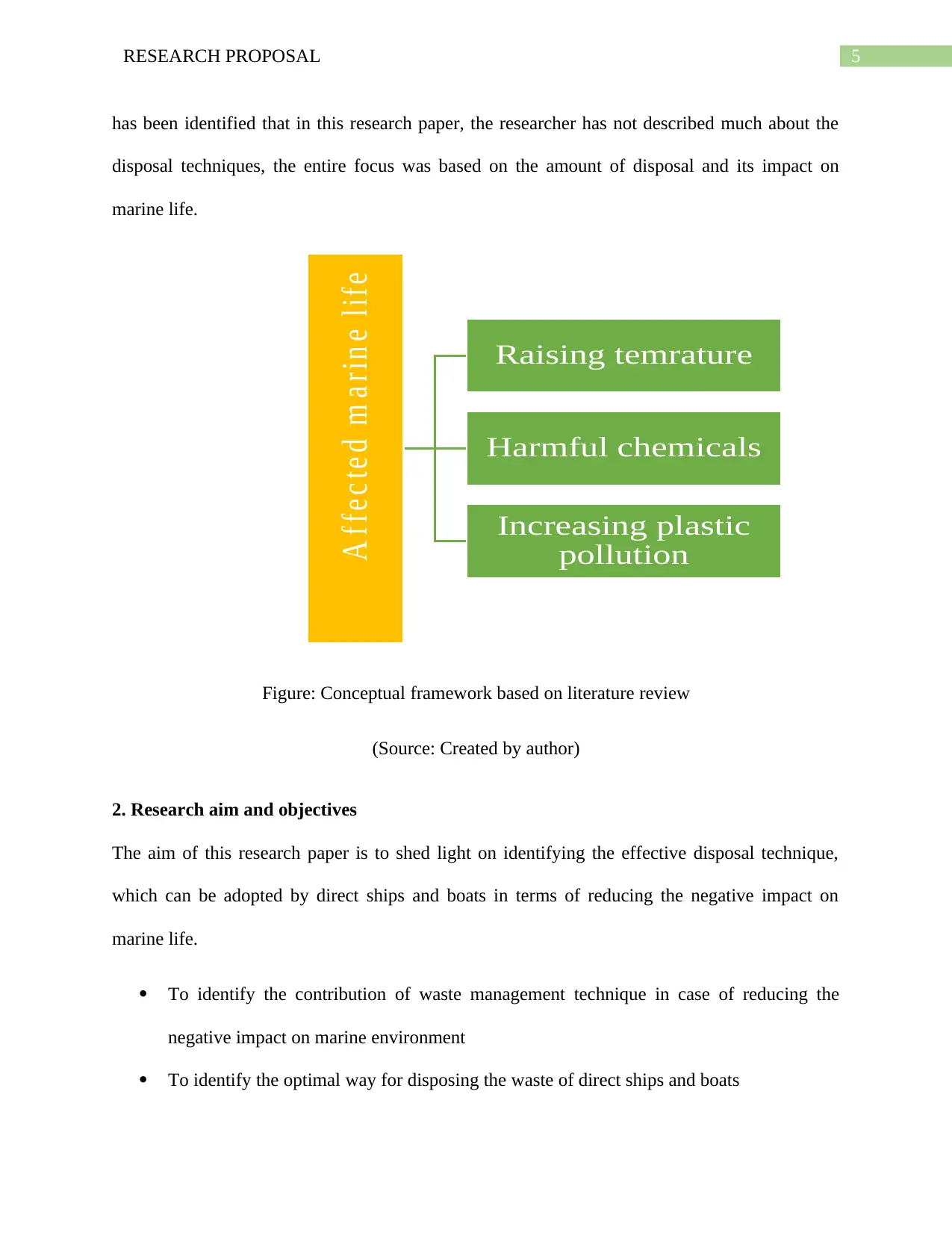
5RESEARCH PROPOSAL
has been identified that in this research paper, the researcher has not described much about the
disposal techniques, the entire focus was based on the amount of disposal and its impact on
marine life.
Figure: Conceptual framework based on literature review
(Source: Created by author)
2. Research aim and objectives
The aim of this research paper is to shed light on identifying the effective disposal technique,
which can be adopted by direct ships and boats in terms of reducing the negative impact on
marine life.
To identify the contribution of waste management technique in case of reducing the
negative impact on marine environment
To identify the optimal way for disposing the waste of direct ships and boats
A f fe c te d m a r in e life
Raising temrature
Harmful chemicals
Increasing plastic
pollution
has been identified that in this research paper, the researcher has not described much about the
disposal techniques, the entire focus was based on the amount of disposal and its impact on
marine life.
Figure: Conceptual framework based on literature review
(Source: Created by author)
2. Research aim and objectives
The aim of this research paper is to shed light on identifying the effective disposal technique,
which can be adopted by direct ships and boats in terms of reducing the negative impact on
marine life.
To identify the contribution of waste management technique in case of reducing the
negative impact on marine environment
To identify the optimal way for disposing the waste of direct ships and boats
A f fe c te d m a r in e life
Raising temrature
Harmful chemicals
Increasing plastic
pollution
⊘ This is a preview!⊘
Do you want full access?
Subscribe today to unlock all pages.

Trusted by 1+ million students worldwide
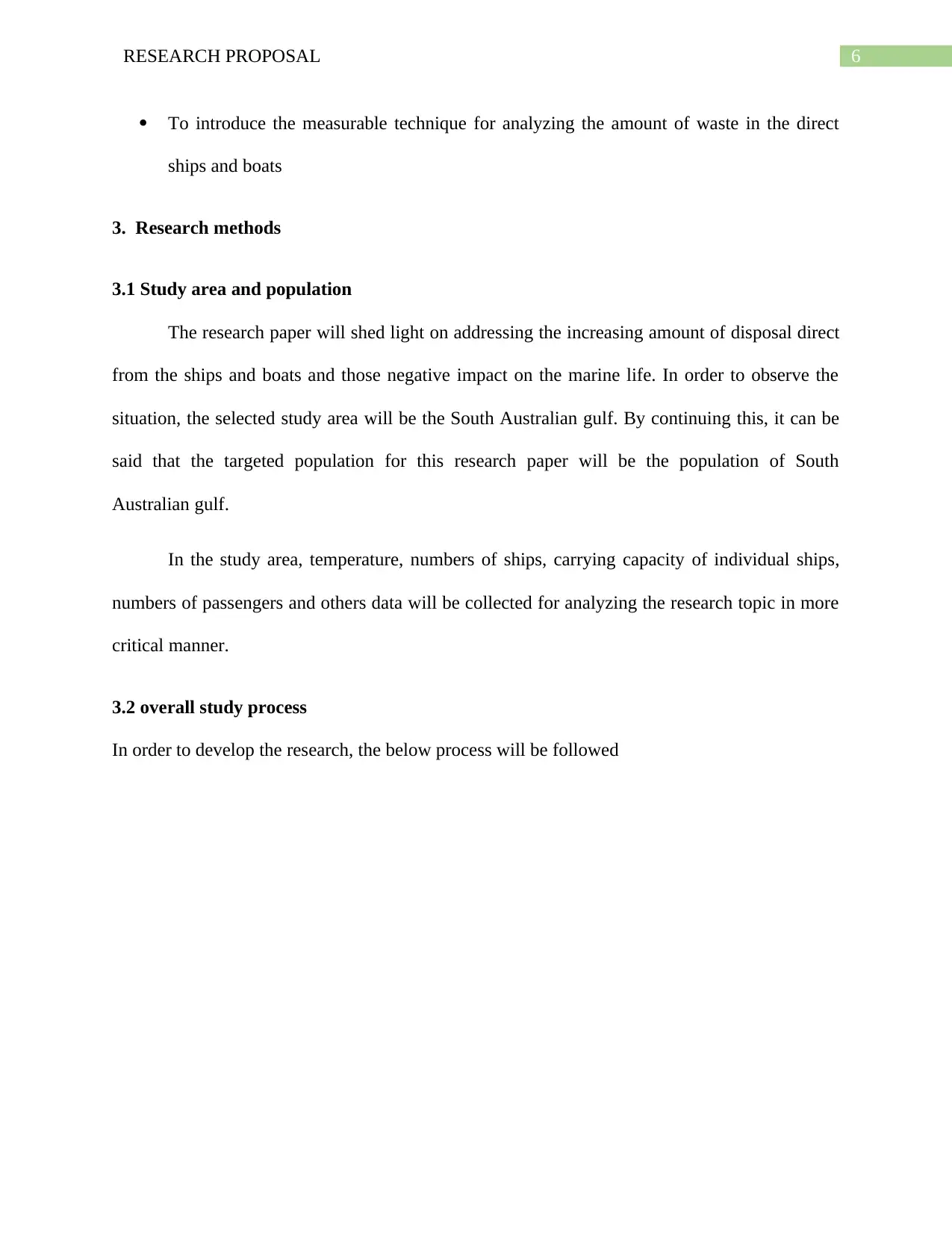
6RESEARCH PROPOSAL
To introduce the measurable technique for analyzing the amount of waste in the direct
ships and boats
3. Research methods
3.1 Study area and population
The research paper will shed light on addressing the increasing amount of disposal direct
from the ships and boats and those negative impact on the marine life. In order to observe the
situation, the selected study area will be the South Australian gulf. By continuing this, it can be
said that the targeted population for this research paper will be the population of South
Australian gulf.
In the study area, temperature, numbers of ships, carrying capacity of individual ships,
numbers of passengers and others data will be collected for analyzing the research topic in more
critical manner.
3.2 overall study process
In order to develop the research, the below process will be followed
To introduce the measurable technique for analyzing the amount of waste in the direct
ships and boats
3. Research methods
3.1 Study area and population
The research paper will shed light on addressing the increasing amount of disposal direct
from the ships and boats and those negative impact on the marine life. In order to observe the
situation, the selected study area will be the South Australian gulf. By continuing this, it can be
said that the targeted population for this research paper will be the population of South
Australian gulf.
In the study area, temperature, numbers of ships, carrying capacity of individual ships,
numbers of passengers and others data will be collected for analyzing the research topic in more
critical manner.
3.2 overall study process
In order to develop the research, the below process will be followed
Paraphrase This Document
Need a fresh take? Get an instant paraphrase of this document with our AI Paraphraser
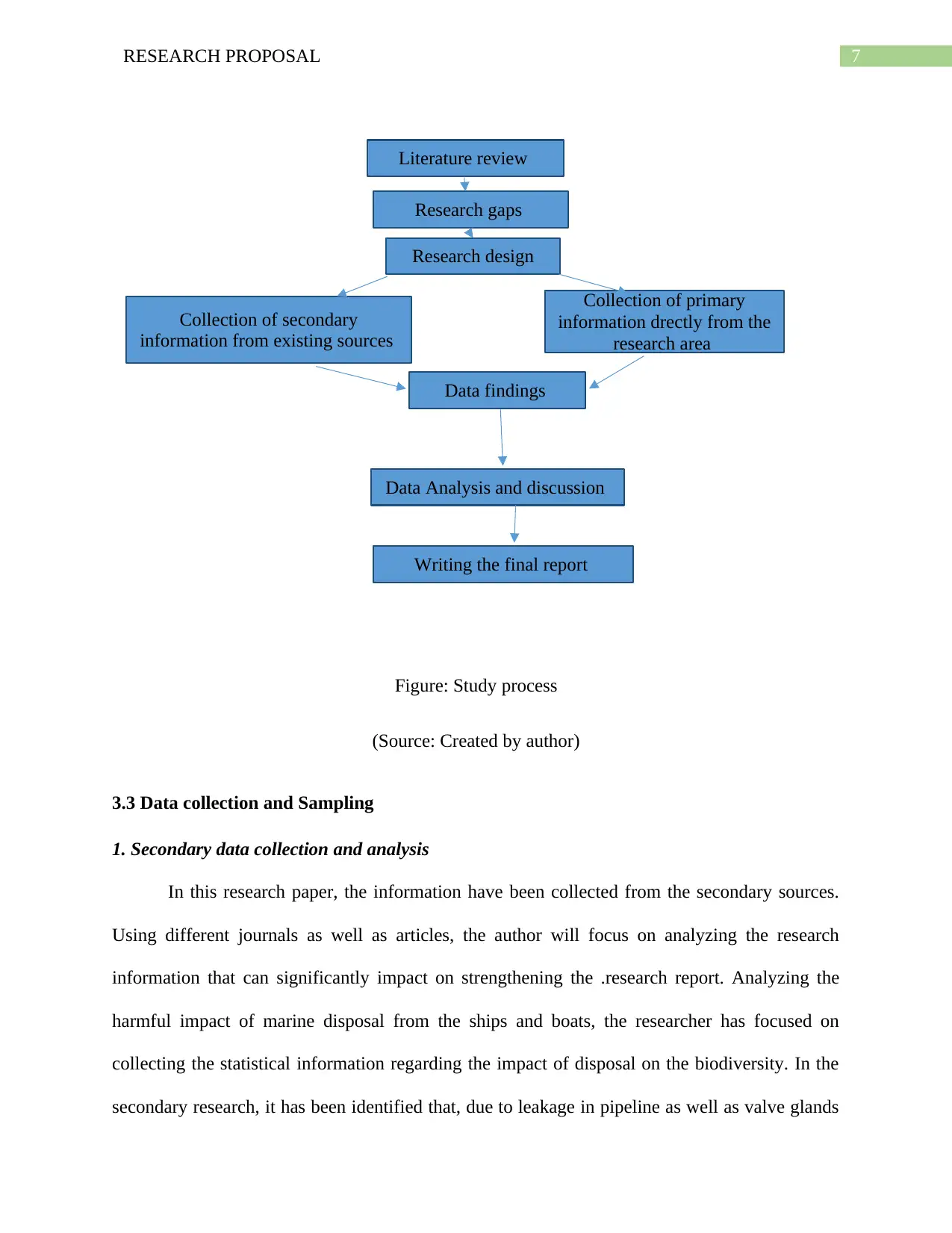
7RESEARCH PROPOSAL
Literature review
Collection of primary
information drectly from the
research area
Collection of secondary
information from existing sources
Research design
Research gaps
Data findings
Data Analysis and discussion
Writing the final report
Figure: Study process
(Source: Created by author)
3.3 Data collection and Sampling
1. Secondary data collection and analysis
In this research paper, the information have been collected from the secondary sources.
Using different journals as well as articles, the author will focus on analyzing the research
information that can significantly impact on strengthening the .research report. Analyzing the
harmful impact of marine disposal from the ships and boats, the researcher has focused on
collecting the statistical information regarding the impact of disposal on the biodiversity. In the
secondary research, it has been identified that, due to leakage in pipeline as well as valve glands
Literature review
Collection of primary
information drectly from the
research area
Collection of secondary
information from existing sources
Research design
Research gaps
Data findings
Data Analysis and discussion
Writing the final report
Figure: Study process
(Source: Created by author)
3.3 Data collection and Sampling
1. Secondary data collection and analysis
In this research paper, the information have been collected from the secondary sources.
Using different journals as well as articles, the author will focus on analyzing the research
information that can significantly impact on strengthening the .research report. Analyzing the
harmful impact of marine disposal from the ships and boats, the researcher has focused on
collecting the statistical information regarding the impact of disposal on the biodiversity. In the
secondary research, it has been identified that, due to leakage in pipeline as well as valve glands
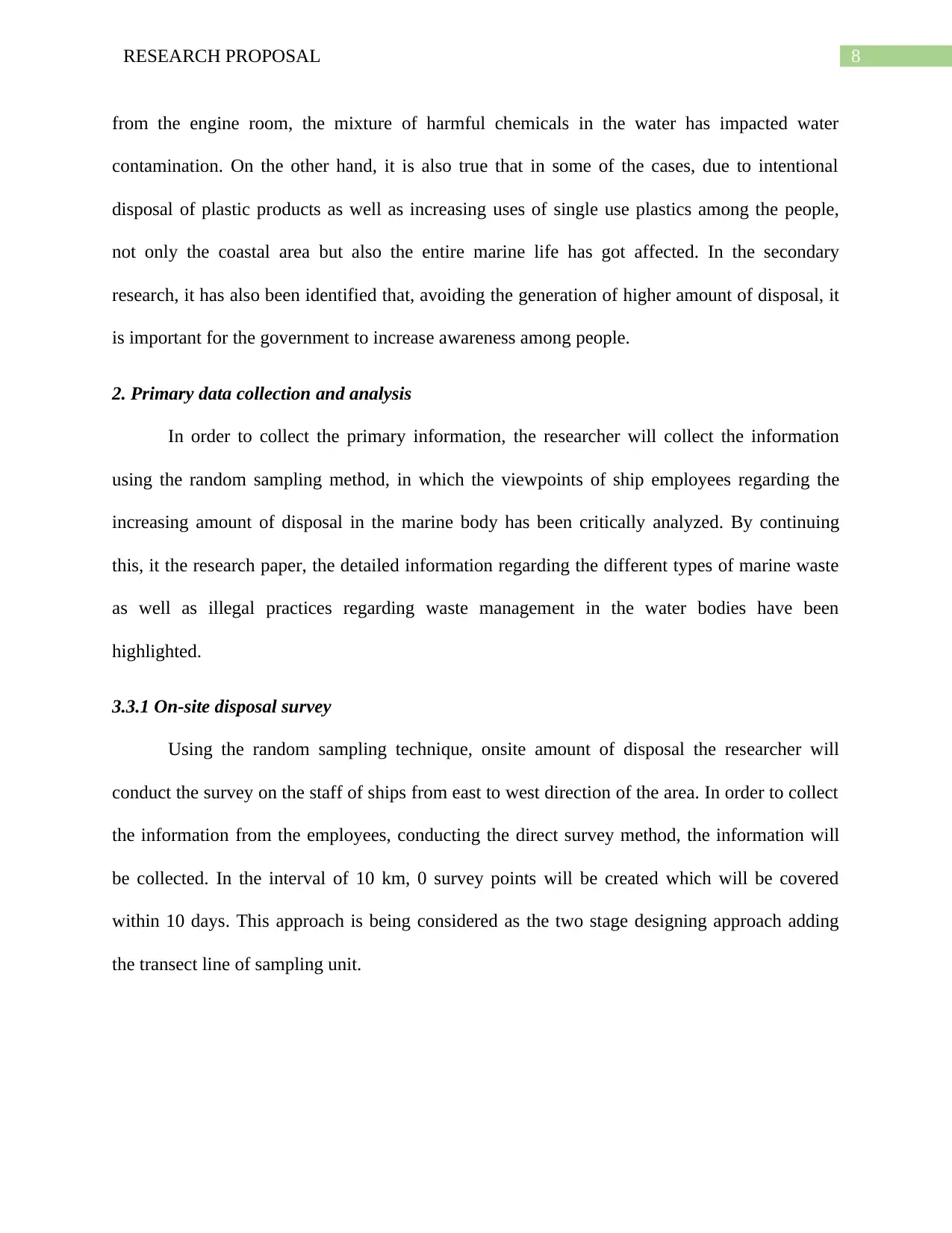
8RESEARCH PROPOSAL
from the engine room, the mixture of harmful chemicals in the water has impacted water
contamination. On the other hand, it is also true that in some of the cases, due to intentional
disposal of plastic products as well as increasing uses of single use plastics among the people,
not only the coastal area but also the entire marine life has got affected. In the secondary
research, it has also been identified that, avoiding the generation of higher amount of disposal, it
is important for the government to increase awareness among people.
2. Primary data collection and analysis
In order to collect the primary information, the researcher will collect the information
using the random sampling method, in which the viewpoints of ship employees regarding the
increasing amount of disposal in the marine body has been critically analyzed. By continuing
this, it the research paper, the detailed information regarding the different types of marine waste
as well as illegal practices regarding waste management in the water bodies have been
highlighted.
3.3.1 On-site disposal survey
Using the random sampling technique, onsite amount of disposal the researcher will
conduct the survey on the staff of ships from east to west direction of the area. In order to collect
the information from the employees, conducting the direct survey method, the information will
be collected. In the interval of 10 km, 0 survey points will be created which will be covered
within 10 days. This approach is being considered as the two stage designing approach adding
the transect line of sampling unit.
from the engine room, the mixture of harmful chemicals in the water has impacted water
contamination. On the other hand, it is also true that in some of the cases, due to intentional
disposal of plastic products as well as increasing uses of single use plastics among the people,
not only the coastal area but also the entire marine life has got affected. In the secondary
research, it has also been identified that, avoiding the generation of higher amount of disposal, it
is important for the government to increase awareness among people.
2. Primary data collection and analysis
In order to collect the primary information, the researcher will collect the information
using the random sampling method, in which the viewpoints of ship employees regarding the
increasing amount of disposal in the marine body has been critically analyzed. By continuing
this, it the research paper, the detailed information regarding the different types of marine waste
as well as illegal practices regarding waste management in the water bodies have been
highlighted.
3.3.1 On-site disposal survey
Using the random sampling technique, onsite amount of disposal the researcher will
conduct the survey on the staff of ships from east to west direction of the area. In order to collect
the information from the employees, conducting the direct survey method, the information will
be collected. In the interval of 10 km, 0 survey points will be created which will be covered
within 10 days. This approach is being considered as the two stage designing approach adding
the transect line of sampling unit.
⊘ This is a preview!⊘
Do you want full access?
Subscribe today to unlock all pages.

Trusted by 1+ million students worldwide
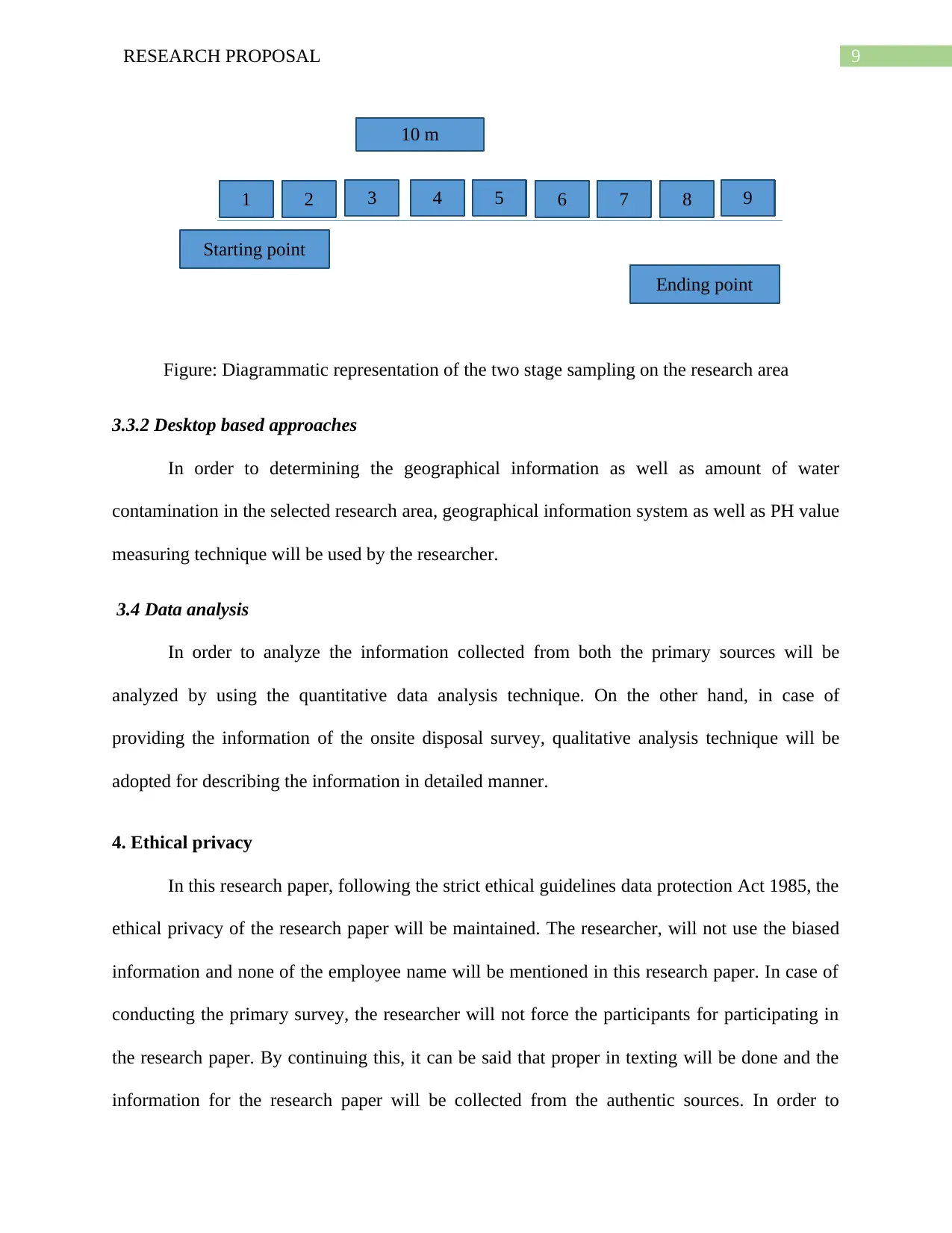
9RESEARCH PROPOSAL
1 432 5 76 98
10 m
Starting point
Ending point
Figure: Diagrammatic representation of the two stage sampling on the research area
3.3.2 Desktop based approaches
In order to determining the geographical information as well as amount of water
contamination in the selected research area, geographical information system as well as PH value
measuring technique will be used by the researcher.
3.4 Data analysis
In order to analyze the information collected from both the primary sources will be
analyzed by using the quantitative data analysis technique. On the other hand, in case of
providing the information of the onsite disposal survey, qualitative analysis technique will be
adopted for describing the information in detailed manner.
4. Ethical privacy
In this research paper, following the strict ethical guidelines data protection Act 1985, the
ethical privacy of the research paper will be maintained. The researcher, will not use the biased
information and none of the employee name will be mentioned in this research paper. In case of
conducting the primary survey, the researcher will not force the participants for participating in
the research paper. By continuing this, it can be said that proper in texting will be done and the
information for the research paper will be collected from the authentic sources. In order to
1 432 5 76 98
10 m
Starting point
Ending point
Figure: Diagrammatic representation of the two stage sampling on the research area
3.3.2 Desktop based approaches
In order to determining the geographical information as well as amount of water
contamination in the selected research area, geographical information system as well as PH value
measuring technique will be used by the researcher.
3.4 Data analysis
In order to analyze the information collected from both the primary sources will be
analyzed by using the quantitative data analysis technique. On the other hand, in case of
providing the information of the onsite disposal survey, qualitative analysis technique will be
adopted for describing the information in detailed manner.
4. Ethical privacy
In this research paper, following the strict ethical guidelines data protection Act 1985, the
ethical privacy of the research paper will be maintained. The researcher, will not use the biased
information and none of the employee name will be mentioned in this research paper. In case of
conducting the primary survey, the researcher will not force the participants for participating in
the research paper. By continuing this, it can be said that proper in texting will be done and the
information for the research paper will be collected from the authentic sources. In order to
Paraphrase This Document
Need a fresh take? Get an instant paraphrase of this document with our AI Paraphraser
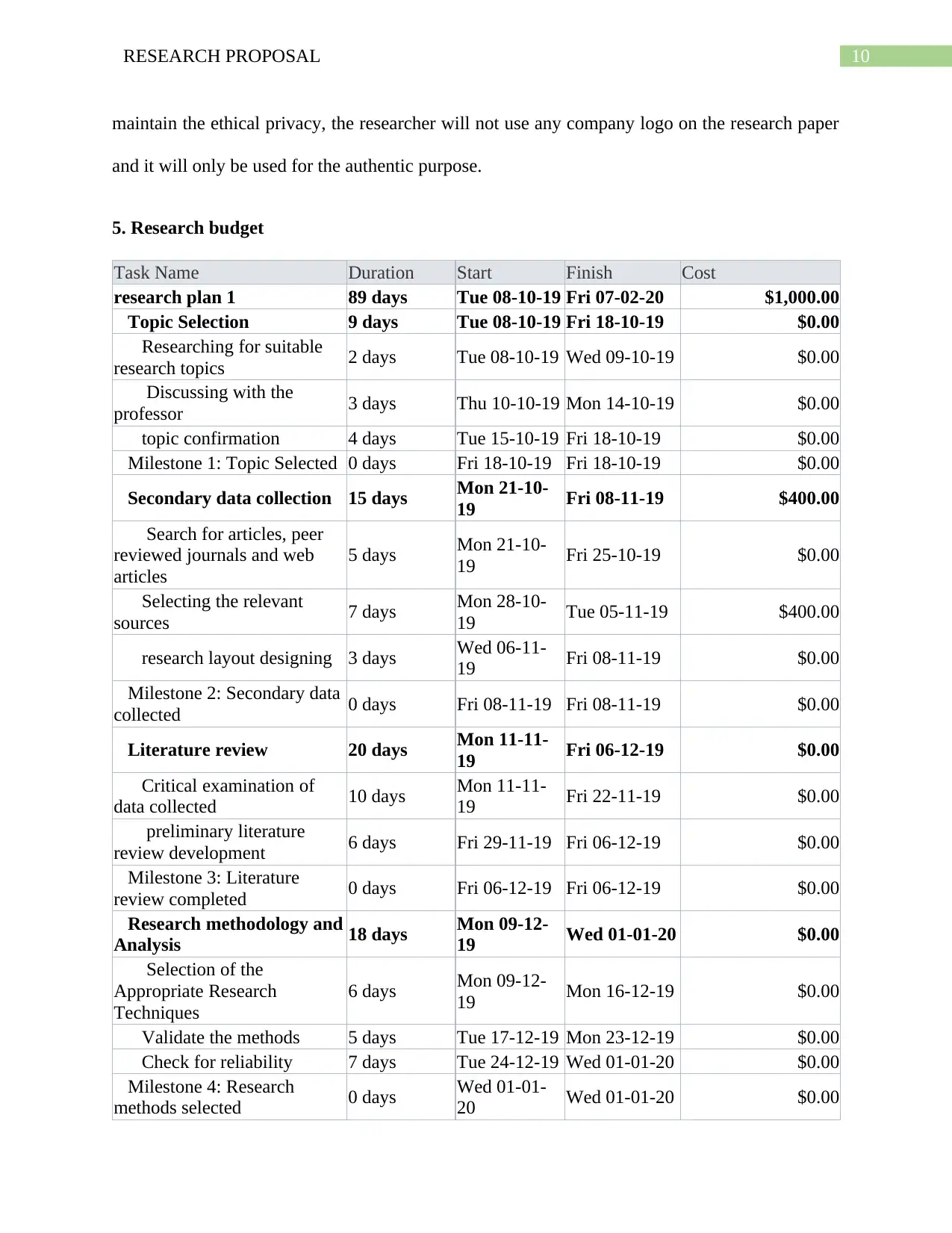
10RESEARCH PROPOSAL
maintain the ethical privacy, the researcher will not use any company logo on the research paper
and it will only be used for the authentic purpose.
5. Research budget
Task Name Duration Start Finish Cost
research plan 1 89 days Tue 08-10-19 Fri 07-02-20 $1,000.00
Topic Selection 9 days Tue 08-10-19 Fri 18-10-19 $0.00
Researching for suitable
research topics 2 days Tue 08-10-19 Wed 09-10-19 $0.00
Discussing with the
professor 3 days Thu 10-10-19 Mon 14-10-19 $0.00
topic confirmation 4 days Tue 15-10-19 Fri 18-10-19 $0.00
Milestone 1: Topic Selected 0 days Fri 18-10-19 Fri 18-10-19 $0.00
Secondary data collection 15 days Mon 21-10-
19 Fri 08-11-19 $400.00
Search for articles, peer
reviewed journals and web
articles
5 days Mon 21-10-
19 Fri 25-10-19 $0.00
Selecting the relevant
sources 7 days Mon 28-10-
19 Tue 05-11-19 $400.00
research layout designing 3 days Wed 06-11-
19 Fri 08-11-19 $0.00
Milestone 2: Secondary data
collected 0 days Fri 08-11-19 Fri 08-11-19 $0.00
Literature review 20 days Mon 11-11-
19 Fri 06-12-19 $0.00
Critical examination of
data collected 10 days Mon 11-11-
19 Fri 22-11-19 $0.00
preliminary literature
review development 6 days Fri 29-11-19 Fri 06-12-19 $0.00
Milestone 3: Literature
review completed 0 days Fri 06-12-19 Fri 06-12-19 $0.00
Research methodology and
Analysis 18 days Mon 09-12-
19 Wed 01-01-20 $0.00
Selection of the
Appropriate Research
Techniques
6 days Mon 09-12-
19 Mon 16-12-19 $0.00
Validate the methods 5 days Tue 17-12-19 Mon 23-12-19 $0.00
Check for reliability 7 days Tue 24-12-19 Wed 01-01-20 $0.00
Milestone 4: Research
methods selected 0 days Wed 01-01-
20 Wed 01-01-20 $0.00
maintain the ethical privacy, the researcher will not use any company logo on the research paper
and it will only be used for the authentic purpose.
5. Research budget
Task Name Duration Start Finish Cost
research plan 1 89 days Tue 08-10-19 Fri 07-02-20 $1,000.00
Topic Selection 9 days Tue 08-10-19 Fri 18-10-19 $0.00
Researching for suitable
research topics 2 days Tue 08-10-19 Wed 09-10-19 $0.00
Discussing with the
professor 3 days Thu 10-10-19 Mon 14-10-19 $0.00
topic confirmation 4 days Tue 15-10-19 Fri 18-10-19 $0.00
Milestone 1: Topic Selected 0 days Fri 18-10-19 Fri 18-10-19 $0.00
Secondary data collection 15 days Mon 21-10-
19 Fri 08-11-19 $400.00
Search for articles, peer
reviewed journals and web
articles
5 days Mon 21-10-
19 Fri 25-10-19 $0.00
Selecting the relevant
sources 7 days Mon 28-10-
19 Tue 05-11-19 $400.00
research layout designing 3 days Wed 06-11-
19 Fri 08-11-19 $0.00
Milestone 2: Secondary data
collected 0 days Fri 08-11-19 Fri 08-11-19 $0.00
Literature review 20 days Mon 11-11-
19 Fri 06-12-19 $0.00
Critical examination of
data collected 10 days Mon 11-11-
19 Fri 22-11-19 $0.00
preliminary literature
review development 6 days Fri 29-11-19 Fri 06-12-19 $0.00
Milestone 3: Literature
review completed 0 days Fri 06-12-19 Fri 06-12-19 $0.00
Research methodology and
Analysis 18 days Mon 09-12-
19 Wed 01-01-20 $0.00
Selection of the
Appropriate Research
Techniques
6 days Mon 09-12-
19 Mon 16-12-19 $0.00
Validate the methods 5 days Tue 17-12-19 Mon 23-12-19 $0.00
Check for reliability 7 days Tue 24-12-19 Wed 01-01-20 $0.00
Milestone 4: Research
methods selected 0 days Wed 01-01-
20 Wed 01-01-20 $0.00
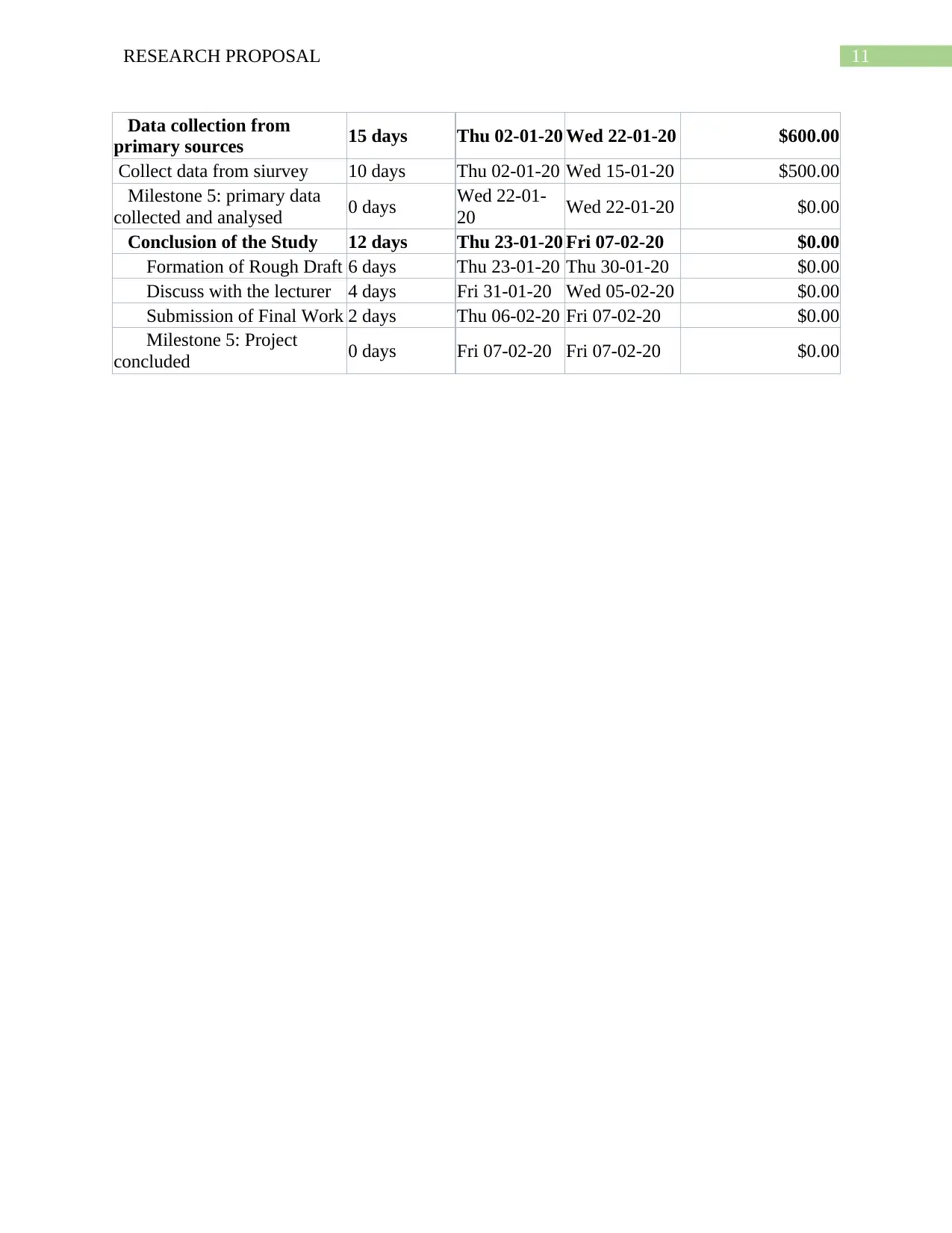
11RESEARCH PROPOSAL
Data collection from
primary sources 15 days Thu 02-01-20 Wed 22-01-20 $600.00
Collect data from siurvey 10 days Thu 02-01-20 Wed 15-01-20 $500.00
Milestone 5: primary data
collected and analysed 0 days Wed 22-01-
20 Wed 22-01-20 $0.00
Conclusion of the Study 12 days Thu 23-01-20 Fri 07-02-20 $0.00
Formation of Rough Draft 6 days Thu 23-01-20 Thu 30-01-20 $0.00
Discuss with the lecturer 4 days Fri 31-01-20 Wed 05-02-20 $0.00
Submission of Final Work 2 days Thu 06-02-20 Fri 07-02-20 $0.00
Milestone 5: Project
concluded 0 days Fri 07-02-20 Fri 07-02-20 $0.00
Data collection from
primary sources 15 days Thu 02-01-20 Wed 22-01-20 $600.00
Collect data from siurvey 10 days Thu 02-01-20 Wed 15-01-20 $500.00
Milestone 5: primary data
collected and analysed 0 days Wed 22-01-
20 Wed 22-01-20 $0.00
Conclusion of the Study 12 days Thu 23-01-20 Fri 07-02-20 $0.00
Formation of Rough Draft 6 days Thu 23-01-20 Thu 30-01-20 $0.00
Discuss with the lecturer 4 days Fri 31-01-20 Wed 05-02-20 $0.00
Submission of Final Work 2 days Thu 06-02-20 Fri 07-02-20 $0.00
Milestone 5: Project
concluded 0 days Fri 07-02-20 Fri 07-02-20 $0.00
⊘ This is a preview!⊘
Do you want full access?
Subscribe today to unlock all pages.

Trusted by 1+ million students worldwide
1 out of 14
Related Documents
Your All-in-One AI-Powered Toolkit for Academic Success.
+13062052269
info@desklib.com
Available 24*7 on WhatsApp / Email
![[object Object]](/_next/static/media/star-bottom.7253800d.svg)
Unlock your academic potential
Copyright © 2020–2025 A2Z Services. All Rights Reserved. Developed and managed by ZUCOL.





